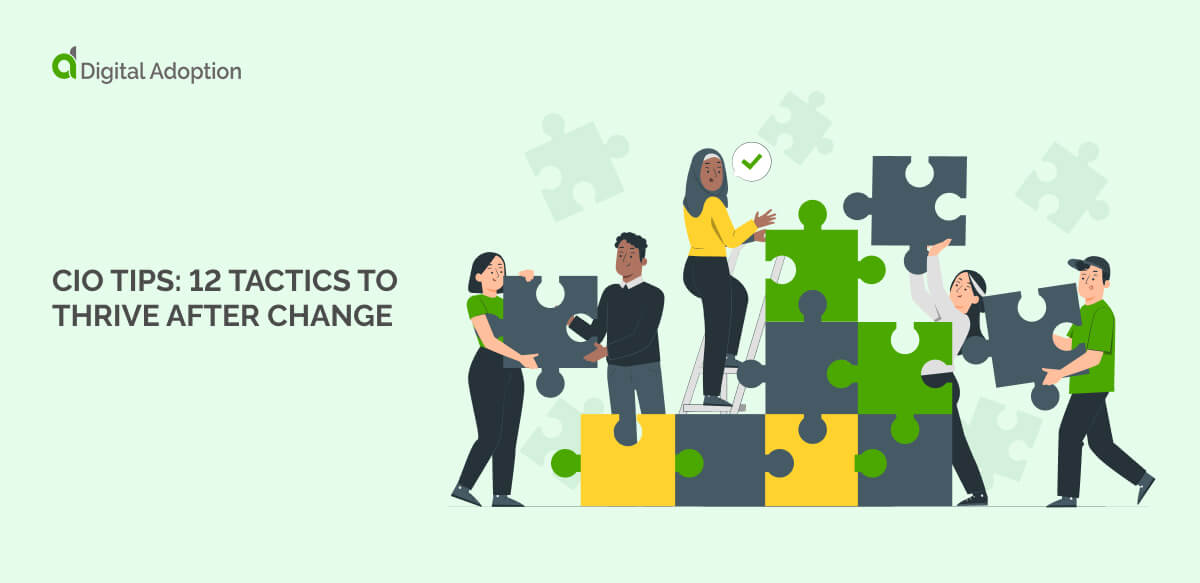For the CIO, the post-COVID era will be challenging, but it will also bring opportunities for those who are prepared. In this post, we’ll cover CIO tips for thriving in the years ahead.
Key takeaways
- CIOs must lead with agility, driving digital transformation strategies that anticipate rapid market and technology shifts.
- Building a strong digital adoption and change management framework is critical for enterprise resilience.
- Investing in innovation and simplifying the digital ecosystem enhance employee experience and operational efficiency.
- Expanding the CIO’s role beyond IT to strategic business leadership is key to sustained digital success.
- Scenario-based planning helps CIOs navigate uncertainty and prepare for multiple future outcomes.
A Guide for the CIO: Tips for the Post-COVID New Normal
Here are a few tips that can help CIOs adapt to the changing world after COVID-19 – or, as some have called it, the “next normal.”
1. Learn how the post-COVID era will differ from the pre-COVID era
According to many research firms, the COVID-19 pandemic was an event that will redefine the way we live, work, and do business.
For instance, research firms such as McKinsey, Accenture, and others predict that:
- Customer sentiment and behavior will shift permanently as a result of the pandemic
- The competitive landscape will be permanently reshaped
- Digital transformation will remain a top priority for some time to come
Preparing for changes such as these is essential, and the best way to begin that preparation is by understanding what those changes will be.
2. Build a digital adoption function
Digital adoption strategies are designed to simplify the adoption of new software which, in turn, can:
- Streamline software implementation
- Simplify the employee experience
- Reduce software-related frustration
- Boost software ROI
Investing in digital adoption platforms (DAPs) and hiring a digital adoption manager are two good steps to start with.
3. Digitize the workplace
During the COVID-19 pandemic, the most digitally mature organizations were the most resilient ones.
Those that were able to adapt to the remote working paradigm most easily, for instance, suffered fewer setbacks than those that could not.
In the post-COVID era, the economy and the business world will become even more digital than it is today, which means, among other things, that only digital workplaces will be able to stay profitable and competitive.
4. Broaden the CIO’s mandate
The CIO has traditionally been responsible for IT service management (ITSM) and IT operations.
Yet in recent years, particularly during the COVID-19 pandemic, CIOs have become business leaders and strategists.
In the years ahead, organizations must become digital-first, which entails digital transformation and organizational change – and CIOs are in an ideal position to lead those technology-driven innovations.
5. Invest in innovation
Building innovation into the business model is one of the most crucial success strategies in the modern era.
It will remain important in the years ahead, since the volatile economic disruptions we saw during 2020 have only just begun.
6. Simplify the digital ecosystem
Today’s digital workplace has become more complicated than ever, thanks to the continual adoption of new technology and tools.
By integrating technology stacks, adopting centralized enterprise software, and simplifying business processes, CIOs can reduce that complexity.
Doing so can significantly improve the employee experience, increase efficiency, and, ultimately, boost employee performance.
| Approach | Description | Ideal Use Case |
|---|---|---|
| Application rationalization | Reducing redundant apps and consolidating platforms. | Mature enterprises with overlapping tools or legacy software. |
| Integration via APIs | Connecting disparate systems for seamless data flow. | Organizations prioritizing cross-departmental collaboration. |
| Unified digital workspace | Creating a central hub for all employee tools and resources. | Hybrid or remote-first teams needing consistent experiences. |
7. Create a change management function
A mature enterprise change management function can ensure that organizational change efforts proceed smoothly and efficiently.
CIOs are often responsible for leading large-scale organizational change efforts, so it is in their best interest to ensure that those projects are successful.
A formal change management department can standardize best practices across the organization which can, in turn, boost the outcomes of CIO-led change projects.
8. Broaden the CIO purview
The CIO’s responsibilities, as mentioned, have been expanding beyond ITSM to include business strategy.
Proactively stepping up to fill that role is one of the best ways CIOs can add value to their organization and meet the challenges of the post-COVID world.
Though this will involve adopting more responsibility – by, for instance, initiating new digital strategies and building relationships with the C-suite – it will strengthen CIO’s position and ultimately improve the organization’s performance.
9. Focus on the digital employee experience
The digital employee experience has a significant impact on employees’ engagement, productivity, and performance.
Simplifying and improving that experience will naturally improve those metrics, so CIOs should work closely with HR professionals to streamline that experience.
This will become particularly important in the post-COVID era, as the hybrid office model becomes increasingly common.
10. Stay agile
Agile business models focus on responsiveness, customer-centrism, and flexibility.
Since, as mentioned, uncertainty and volatility will continue well into the post-COVID era, it is important to build an agile, flexible organization.
11. Cultivate a digital-first culture
Organizational culture is another factor that affects employee engagement and productivity, as well as organizational change efforts.
A digital-first workplace culture embeds digital tools not only into business processes, but also into mindsets and attitudes.
CIOs who inculcate digital into the company’s cultural DNA will enhance their company’s ability to survive in the digital future.
12. Plan for multiple futures
The future is unwritten and, as mentioned, it will remain volatile for some time to come.
Yet, despite that volatility, the post-COVID recovery can be modeled and categorized into a few specific scenarios.
In such an uncertain environment, scenario-based planning can mitigate risk and help CIOs stay prepared for a number of potential recovery pathways.

 FACT CHECKED
FACT CHECKED







